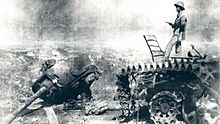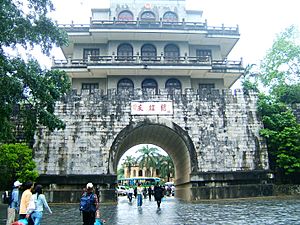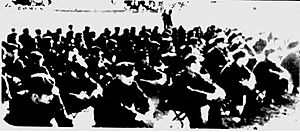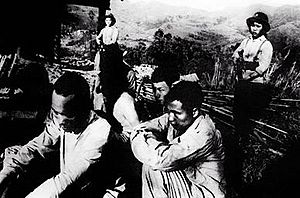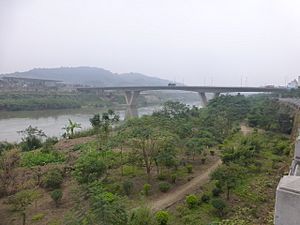Sino-Vietnamese War facts for kids
Quick facts for kids Sino-Vietnamese War |
|||||||||
|---|---|---|---|---|---|---|---|---|---|
| Part of the Third Indochina War and the Cold War | |||||||||
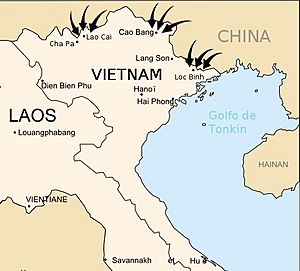 Map of Vietnamese cities that were attacked by China. |
|||||||||
|
|||||||||
| Belligerents | |||||||||
|
|||||||||
| Commanders and leaders | |||||||||
|
|
||||||||
| Strength | |||||||||
|
|||||||||
| Casualties and losses | |||||||||
|
|
||||||||
The Sino-Vietnamese War (Vietnamese: Chiến tranh biên giới Việt-Trung; Chinese: 中越战争; pinyin: Zhōng-Yuè Zhànzhēng) was a short border war between China and Vietnam in early 1979. China started the attack because Vietnam had invaded Cambodia in 1978. Vietnam's actions ended the rule of the Khmer Rouge, a group in Cambodia that China supported. Both China and Vietnam said they won this war, which was the last of the Indochina Wars.
Chinese forces went into northern Vietnam and took over several cities near the border. On March 6, 1979, China announced that their mission was complete. Chinese troops then left Vietnam. However, Vietnamese troops stayed in Cambodia until 1989. This meant China did not fully achieve its goal of making Vietnam leave Cambodia. After the dissolution of the Soviet Union in 1991, the border between China and Vietnam was finally settled.
Even though China could not make Vietnam leave Cambodia, the war showed something important. It proved that the Soviet Union, China's rival during the Cold War, could not fully protect its ally, Vietnam.
Contents
Names for the War
The Sino-Vietnamese War (Vietnamese: Chiến tranh biên giới Việt-Trung) is also called the Third Indochina War. This helps tell it apart from the First Indochina War and the Vietnam War (also known as the Second Indochina War).
In Vietnam, people call it the War against Chinese expansionism (Vietnamese: Chiến tranh chống bành trướng Trung Hoa). In China, it is known as the Defensive Counterattack against Vietnam (Chinese: 对越自卫反击战; pinyin: Duì Yuè zìwèi fǎnjī zhàn).
Why the War Happened
The Sino-Vietnamese War, like earlier conflicts in Indochina, grew out of old problems between countries. After World War II, major world powers like the United Kingdom, the United States, and the Soviet Union agreed that France should control Indochina again.
Since France could not immediately take back control, the British took charge in the south. Chinese Nationalist forces moved into the north. These Chinese troops disarmed Japanese soldiers north of the 16th parallel in September 1945. This line divided Indochina into Chinese and British zones. The British helped French forces take back southern Vietnam.
Ho Chi Minh, a Vietnamese leader, first tried to talk with the French. In March 1946, Ho signed a deal allowing French troops to replace the Chinese. In return, France recognized Vietnam as a "free" republic within the French Union. The British left in March 1946, leaving Vietnam to the French. Soon, the Vietnamese started a guerrilla war against the French. This began the First Indochina War.
French Rule and the First Indochina War
Vietnam became a French colony in 1858. By the 1880s, France controlled all of Vietnam. By 1893, Laos and Cambodia also became French colonies. Many rebellions against French rule happened before World War I. The war in Europe made people in Southeast Asia want independence even more. Leaders like Ho Chi Minh became very popular.
Before attacking Pearl Harbor, Japan took over French Indochina. But they let the French government (Vichy French) still run things. In March 1945, Japan took full control, creating their own puppet government called the Empire of Vietnam. When Japan surrendered in August 1945, there was no clear power in Indochina. Different groups fought for control.
The Viet Minh quickly tried to set up the Democratic Republic of Vietnam. The French who were still there agreed, waiting for more French forces to return. The Kuomintang (Chinese Nationalists) supported France taking back control. But Chinese communists, backed by the Soviet Union, helped the Viet Minh fight for independence. The Soviet Union later directly supported Ho Chi Minh.
The First Indochina War had a big impact on the region. In July 1954, the Geneva Conference led to an agreement to reunite Vietnam. China, Russia, and Western European countries supported this. The U.S. did not sign the agreement and quickly started supporting South Vietnam.
The Sino-Soviet Split
The Communist Party of China and the Viet Minh had a long history. In the early part of the First Indochina War, China helped the Viet Minh. China was the link between the Soviet Union and the Viet Minh.
After Joseph Stalin died in 1953, relations between the Soviet Union and China got worse. Mao Zedong, China's leader, disagreed with the new Soviet leader, Nikita Khrushchev. Mao thought Khrushchev made a mistake by criticizing Stalin. This led to the Sino-Soviet split. After this, China helped its former allies in Vietnam less, because Vietnam did not support China against the Soviets.
Because of this split, China placed about 1.5 million troops along its border with the Soviet Union. They were ready for a full-scale war. After Mao died in 1976, Deng Xiaoping came to power in China. He changed China's policies to be more open to trade with the West. China also started working with the U.S. against the Soviet Union.
The Vietnam War
When France left Vietnam in late 1954, the United States stepped in to support South Vietnam. The U.S. feared the Domino theory. This idea said that if one country became communist, nearby countries would also fall to communism. The Soviet Union and North Vietnam became close allies. China, however, worried about the growing Soviet-Vietnamese friendship. They feared being surrounded by Soviet influence.
The U.S. and the Soviet Union could not agree on elections to unite Vietnam. So, South Vietnam held its own election in 1955. Many people thought this election was unfair. This led to more fighting with communist groups like the Viet Cong. North Vietnamese forces, with Soviet support, joined the fighting in 1959. They openly invaded the South in 1964.
The U.S. played a bigger and bigger role in supporting South Vietnam. By 1968, over 500,000 American troops were in Vietnam. But with no clear victory and growing opposition at home, the U.S. began to pull out its troops in 1969. They tried to strengthen South Vietnam's military so it could fight on its own. By March 1973, all U.S. combat forces had left. However, North Vietnamese troops were allowed to stay. North Vietnam attacked South Vietnam in early 1975, and South Vietnam fell on April 30, 1975.
China started talks with the United States in the early 1970s. These talks led to a new friendship between China and the U.S. At the same time, China also supported the Khmer Rouge in Cambodia.
Cambodia
Vietnamese communists and the Khmer Rouge used to work together. But their relationship got bad when Khmer Rouge leader Pol Pot took power in Cambodia in April 1975. China supported the Khmer Rouge against other groups in Cambodia. China gave the Khmer Rouge a lot of political, supply, and military help.
After many fights along the border between Vietnam and Cambodia, Vietnam invaded Cambodia on December 25, 1978. This happened with encouragement from Khmer Rouge soldiers who had left their group. By January 7, 1979, Vietnamese forces had entered Phnom Penh, Cambodia's capital. The Khmer Rouge leaders fled to western Cambodia.
Ethnic Minorities
China supported a group called the United Front for the Liberation of Oppressed Races (FULRO) against Vietnam. This group was made of ethnic minorities.
The Vietnamese punished people who worked with the Chinese, no matter their background. Many people from the Thu Lao and Phù Lá ethnic groups in Vietnam moved to China during the war. China received so many defectors that Vietnam was shocked. Vietnam then tried to regain control over its ethnic minorities. China and Thailand also supported the Hmong and FULRO against Vietnam.
China Attacks Vietnam
China, now led by Deng Xiaoping, was starting to open its economy and trade with Western countries. China was becoming more against the Soviet Union. On November 3, 1978, the Soviet Union and Vietnam signed a 25-year defense treaty. This made Vietnam a key ally for the Soviet Union against China.
On January 1, 1979, Chinese Vice-premier Deng Xiaoping visited the United States. He told President Jimmy Carter, "The little child is getting naughty, it's time he got spanked." This referred to Vietnam. On February 15, Deng Xiaoping announced that China planned a limited attack on Vietnam.
China said the attack was to help its ally, the Khmer Rouge in Cambodia. They also said it was because Vietnam mistreated its ethnic Chinese minority and occupied the Spratly Islands, which China claimed. To stop the Soviet Union from helping Vietnam, Deng warned Moscow that China was ready for a full war against them. China moved many troops to its border with the Soviet Union. They even moved 300,000 civilians away from the border.
How the Armies Were Set Up
Chinese Forces
The Chinese army, called the People's Liberation Army (PLA), had many more soldiers than Vietnam. But China had to keep most of its troops along its northern border with the Soviet Union. This was to stop the Soviets from getting involved.
The Chinese forces that fought in Vietnam came from several military regions. They were led by headquarters in Kunming (western front) and Guangzhou (eastern front). Some Chinese troops had helped North Vietnam against South Vietnam just a few years earlier. About 200,000 Chinese troops entered North Vietnam. Another 400,000 were moved from their usual bases during the war.
U.S. spy satellites watched the Chinese troop movements. When Deng Xiaoping visited the U.S. in 1979, he confirmed these numbers were correct. After this, Chinese media was allowed to report on the troop movements.
Vietnamese Forces
The Vietnamese government said they had about 70,000 soldiers, including regular army divisions, in their northern area. However, China estimated the number was more than twice that. Some Vietnamese forces used American military equipment captured during the Vietnam War.
The Vietnamese army had different military regions. The 1st Military Region defended the Northeast. It included infantry divisions and local forces. The 2nd Military Region defended the Northwest. It also had infantry divisions and local forces. In addition, about 50,000 militia members supported the army in each region.
The Vietnam People's Air Force did not fight directly. Instead, they supported ground troops. They moved soldiers from Cambodia to northern Vietnam and flew reconnaissance missions. The Vietnamese also had strong air defense units in the northern and northwestern regions.
The War's Progress
Preparing for War
Vietnam said that China performed many spying activities across the border starting in January 1979. China also made 230 invasions into Vietnamese land. To get ready for a possible Chinese attack, Vietnam's military leaders told all armed forces near the border to be ready.
China's Attack
On February 17, 1979, about 200,000 PLA troops entered northern Vietnam. They were supported by 200 tanks. This was the PLA's first big combat operation since the Korean War in 1953.
The PLA attacked in two main directions:
- The western attack, led by Xu Shiyou, aimed for Cao Bằng, Lạng Sơn, and Quảng Ninh Provinces.
- The eastern attack, led by Yang Dezhi, aimed for Ha Tuyen, Hoang Lien Son, and Lai Châu Provinces.
Vietnam's Response
Vietnam quickly moved its main forces from Cambodia, southern Vietnam, and central Vietnam to the northern border. From February 18 to 25, two infantry divisions were sent to defend the northwestern region. From March 6 to 11, the Second Corp, which was in Cambodia, was moved back to Hanoi.
Air force units from central and southern Vietnam were also quickly sent north.
Soviet Support for Vietnam
The Soviet Union did not fight directly in the war. But it gave Vietnam important intelligence and equipment. The Soviets set up a large airlift to move Vietnamese troops from Cambodia to northern Vietnam. Moscow also provided 400 tanks, 500 artillery pieces, 50 rocket launchers, and 20 jet fighters. About 5,000 to 8,000 Soviet military advisers were in Vietnam in 1979 to train soldiers.
During the war, the Soviet Union moved troops to its borders with China and Mongolia. This was to show support for Vietnam and to keep Chinese troops busy. However, the Soviets refused to take any direct action to defend Vietnam.
The Soviet Pacific Fleet also sent 15 ships to the Vietnamese coast. These ships helped relay Chinese battlefield communications to Vietnamese forces.
Why the Soviets Did Not Act Directly
Even though the Soviet Union sent ships and supplies, they felt they could not directly support Vietnam against China. The distance was too great, and any help would have to cross land controlled by China or U.S. allies. The only real option would have been to restart their border conflict with China. Vietnam was important to Soviet policy, but not important enough to start a war over. When Moscow did not intervene, China publicly said that the Soviet Union had broken its promises to help Vietnam.
Another reason for Moscow's inaction was that China had promised both Moscow and Washington that the invasion would be limited. China said its forces would pull back after a short attack. After the U.S. helped calm things down, Moscow decided to wait and see if China would keep its promise. Deng Xiaoping ordered the Chinese navy and air force to stay out of the war. This was to reassure Moscow that it was a limited war. When China kept its promise, Moscow did not fight back.
The Fighting
The PLA quickly moved about 15–20 kilometers into Vietnam. Most of the fighting happened in the provinces of Cao Bằng, Lào Cai, and Lạng Sơn. The Vietnamese army avoided using their main divisions. They kept about 300,000 troops ready to defend Hanoi. The People's Army of Vietnam (VPA) often used guerrilla tactics, avoiding direct battles.
The first Chinese attack soon slowed down. A new wave of eight PLA divisions joined the fight. After taking the northern hills above Lạng Sơn, the PLA surrounded the city. They paused to try and make the VPA send more troops from Cambodia. This was a key part of China's war plan, as Deng did not want to make things worse with the Soviet Union. After three days of intense house-to-house fighting, Lạng Sơn fell on March 6. The PLA then took the southern hills above Lạng Sơn and occupied Sa Pa. The PLA claimed to have defeated several of the VPA's regular units.
China's Withdrawal
On March 6, China announced that the way to Hanoi was open and their mission was done. As they returned to the Chinese border, the PLA destroyed local buildings and roads. They also took useful equipment and resources, like livestock. This severely damaged the economy of northern Vietnam. The PLA crossed back into China on March 16. Both sides claimed victory. China said they crushed Vietnamese resistance. Vietnam said they pushed back the invasion mostly with local militias. Many Western writers agree that Vietnam fought better than the PLA.
After the War
Both China and Vietnam lost thousands of soldiers. China also lost 3.45 billion yuan, which slowed down their economic plans. After the war, Vietnam took steps to deal with people who might have helped China. In spring 1979, they moved about 8,000 Hoa people (ethnic Chinese) from Hanoi to new economic zones in the south. They also moved some Hmong tribes and other ethnic minorities from the northern provinces. A purge was launched to remove pro-Chinese people from the Communist Party of Vietnam. In 1979, over 20,000 members were removed from the party.
Even though Vietnam continued to occupy Cambodia, China successfully got other countries to oppose the occupation. China improved its relations with ASEAN countries like Thailand and Singapore. They promised to protect them from "Vietnamese aggression." In contrast, Vietnam became more dependent on the Soviet Union. Vietnam leased a naval base at Cam Ranh Bay to the Soviets. Some historians believe China's leader, Deng Xiaoping, started the war to keep the army busy while he gained more power.
Casualties
The number of people killed or injured in the war is debated. Vietnamese sources claimed China had 62,500 total casualties, including many vehicles and artillery pieces destroyed. A Chinese activist said in 1980 that China had 9,000 dead and about 10,000 wounded. Leaks from Chinese military sources suggest China had 6,954 dead.
The Vietnamese government has never officially announced its military casualties. China estimated that Vietnam lost 57,000 soldiers and 70,000 militia members. A Vietnamese newspaper claimed that Vietnam suffered over 100,000 civilian deaths. It also reported heavy losses of industry and farms.
Prisoners of War
China held 1,636 Vietnamese prisoners, and Vietnam held 238 Chinese prisoners. They were exchanged in May–June 1979.
The 238 Chinese soldiers surrendered after being separated from their unit during the withdrawal. They reported being treated badly in prison, including being blindfolded and tied with metal wire.
China-Vietnam Relations After the War
Border fights continued throughout the 1980s. This included a big fight in April 1984 and a naval battle over the Spratly Islands in 1988.
The armed conflict ended in 1989 after Vietnam agreed to fully leave Cambodia. Both countries secretly planned to make their relations normal again in September 1990. They officially became friends again in November 1991.
In 1999, after many years of talks, China and Vietnam signed a border agreement. The land border was adjusted. Vietnam gave China back some land lost during the war, including the Ai Nam Quan Gate. This gate was a traditional border marker. This caused frustration in Vietnam. Vietnam's official news said the new border was in place around August 2001. In January 2009, the border was officially marked. The Paracel Islands and Spratly Islands are still a point of disagreement between the two countries.
In December 2007, a plan was announced to build a highway between Hanoi and Kunming. This was a big step in China-Vietnam relations. The road will cross the border that was once a battlefield. It is expected to help make the border region more peaceful and improve trade between the two nations.
See also
 In Spanish: Guerra sino-vietnamita para niños
In Spanish: Guerra sino-vietnamita para niños


